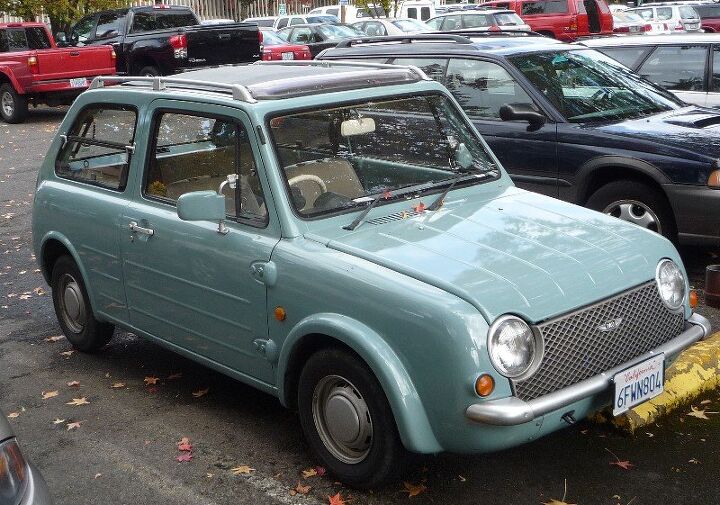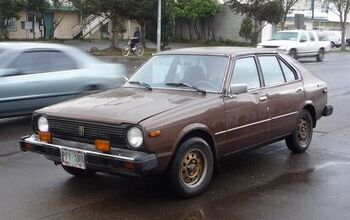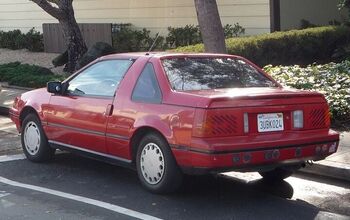Curbside Classic: 1989 Nissan Pao

Oregonians have long treasured the random little collectable objects that Japan’s artisans inadvertently send our way. Usually that takes the form of beautiful hand-blown glass fishing floats that spend years or decades bobbing in the Pacific before a storm washes them on our shores. But occasionally another form of distinctly Japanese objet d’art finds its way ashore, like this Nissan Pao.
Stephanie and I were driving down Oak Street, when I had a split-second glimpse of its grille sitting up on the upper level of a parking ramp. Holy Kapao! popped out of my mouth, as I instantly pulled a rude maneuver to get into the parking ramp. What the hell is that doing in Eugene!? My wife asked me how I could have possibly seen it up there while driving. Don’t ask.
When we found it hiding tucked up close to a stairway shaft, Stephanie had a palpable hormono-vascular reaction. Like most Americans, she had no clue of the Pao’s existence. Now she would have settled for a new Mini in a pinch, but, prior to seeing the Poa, a Mini Traveler is what she really wanted. But the one is too common (and overpriced), the other too impractical. The Pao is the proverbial missing link.
Well, didn’t I feel full of myself telling her all about the Pao, how I’ve always had a soft spot for it, and how it started the whole Japanese retro fad that raged for a few years there, thanks to Nissan’s indulgence. The Pike Factory was set up to be a limited production facility geared to small batches, the goal not being profits, but image enhancement for Nissan, which frankly needed it back then.
The lowly and boxy Nissan Micra K10 was drafted to be the donor platform for the Pikes Factory specials, and the Pao was its first radical makeover. Premiering at the Tokyo show in 1987, the Pao is a rolling pastiche of retro cues gathered and rearranged from around the globe: mostly original mini, but also pieces of 2CV, Beetle, Mehari, mini-moke, and Austin 1100; am I forgetting somebody? It was followed shortly by the much less creative Be-1, and then by the brilliant little Figaro. The goofy S-Cargo rounded out the Pikes family, before the Nissan fun-mobile exercise petered out.
The Pao’s production was purposely limited to 10k units for the Japanese domestic market only, and interested parties had to submit a reservation from January 15 through April 14, 1989; orders were served according to their date of placing. The new fashion darling sold out in three months and is still sought after. But the question as to whether the Pao is a worthy work of art or a flash in the pop-pan is as questionable as Wikipedia’s reliability. It claims that the Pao is on permanent display in the Museum of Modern Art in New York along with those other timeless automotive masterworks residing there: the 1946 Cisitalia 202 GT, a Willys Jeep, a ’59 Beetle and a ’63 XKE. But a search of MoMA’s press releases on the subject of Pao draws a big zero. Has anybody in NY seen it there?
Well, somebody in Eugene sure wanted it in their collection. Actually, it’s a daily driver, and it now spends its rainy days on a surface lot off Pearl Street, which made it possible to get some decent shots of it. It’s definitely a city car, what with all of 51 horsepower from the carbureted 987cc Micra engine. At least this one had the desirable five-speed stick; the three-speed automatic is best kept for Tokyo’s traffic jams.
At least those 51 ponies only have 1600 lbs to pull. The Pao is about the same size as the new Mini, but its weight is a lot closer to the original mini’s. And the Pao’s interior has it all over the Mini stylistically, if not in comfort and features. The round speedometer and authentic-looking retro flip-switches work; the current Mini arcade game IP is almost unbearable to look at.
Want one? There available through Japanese exporters; though they seem to go fairly quickly, with prices roughly in the $3 to $6k range. Stephanie did, badly, until the reality of right hand drive set in. Pass. Well, the Pao and Figaro are particularly popular in the UK for at least that one reason. For anyone with good taste wanting a true mini successor, the new Mini doesn’t just doesn’t cut it. How much to convert one to left-hand drive?

More by Paul Niedermeyer
Latest Car Reviews
Read moreLatest Product Reviews
Read moreRecent Comments
- Drnoose Tim, perhaps you should prepare for a conversation like that BEFORE you go on. The reality is, range and charging is everything, and you know that. Better luck next time!
- Buickman burn that oil!
- Jkross22 Meant to ask.... what's the best oil to use in a popcorn popper? I've been wanting to try peanut oil, but can't find anything smaller than the huge container at smart n final.
- Ajla A union fight? How retro 😎
- Analoggrotto Finally, some real entertainment: the Communists versus the MAGAs. FIGHT!





































Comments
Join the conversation
As usual, Paul, this is a great article...but I can't sit still over the statement that the Pao "started the whole Japanese retro fad." I think that at least some credit is owed to Mazda, for its MX-5/Miata. While definitely a then-modern interpretation of the classic British roadster, the design pays homage to styling cues of the past, particularly in its packaging. On a similar note, I've always been a fan of the Figaro and would love to own one, even though I now know its popular among British trophy wives. But then again, I'm comfortable with my masculinity...
Car still in Eugene, still w/Cali plates. 3/22/2012 I drooled over it @ Woodfield Station lot in South Eugene (Market of Choice). Very nice. -E